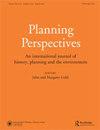Manila’s Architectural Heritage 1571-1960. Volume 1 The Center: Intramuros, Binondo, San Nicolas, Tondo
IF 0.9
3区 历史学
0 ARCHITECTURE
引用次数: 0
Abstract
gence of history and traditional knowledge. Mehaffy then embarks on a genuinely ambitious philosophical digression, which somewhat distracts from the main purpose of the book (section III), followed by arguments on the link between the New Urban Agenda and the principles of Jacobs and Alexander (section IV). Finally, in section V he recapitulates around five key lessons with corresponding ‘hopeful examples’: the first, connectivity, is illustrated by the city of Portland, Oregon; the second, opportunities for all, by the exceptional experience of Medellín/Colombia; the third, adaptation, by Alexander’s own project for the Eishin School in Tokyo; the fourth, environmental sustainability, by Freiburg/Germany; and the fifth, system reformwith the example of the plans for the recovery of New Orleans after Hurricane Katrina, in which the author was involved. Despite the scepticism and mistrust that may be aroused by some superficial readings or those that seek to apply Jacobs’ or Alexander’s principles literally to current urban realities, re-reading them, as Mehaffy acknowledges, allows us to test their ideas, verify them, modify them, combine them with others and, if they seem useful, proceed to apply them constructively or, failing that, revise them as convenient.马尼拉的建筑遗产1571-1960。第1卷中心:Intramuros,Binondo,San Nicolas,Tondo
历史与传统知识的融合。然后,Mehaffy开始了一个真正雄心勃勃的哲学题外话,这在一定程度上分散了本书的主要目的(第三部分),随后是关于《新城市议程》与雅各布斯和亚历山大原则之间联系的争论(第四部分)。最后,在第五部分,他用相应的“充满希望的例子”概括了大约五个关键教训:第一,连通性,由俄勒冈州波特兰市说明;第二,通过Medellín/哥伦比亚的特殊经验为所有人提供机会;第三个是改编,是亚历山大自己为东京爱新学校设计的;第四个是环境可持续性,由德国弗莱堡设计;第五,制度改革,以笔者参与的卡特里娜飓风后的新奥尔良灾后重建方案为例。尽管一些肤浅的阅读或那些试图将雅各布斯或亚历山大的原则应用于当前城市现实的人可能会引起怀疑和不信任,但正如Mehaffy所承认的那样,重新阅读它们允许我们测试他们的想法,验证它们,修改它们,将它们与其他想法结合起来,如果它们看起来有用,则继续建设性地应用它们,否则,修改它们以方便。
本文章由计算机程序翻译,如有差异,请以英文原文为准。
求助全文
约1分钟内获得全文
求助全文
来源期刊

Planning Perspectives
Multiple-
CiteScore
1.50
自引率
12.50%
发文量
85
期刊介绍:
Planning Perspectives is a peer-reviewed international journal of history, planning and the environment, publishing historical and prospective articles on many aspects of plan making and implementation. Subjects covered link the interest of those working in economic, social and political history, historical geography and historical sociology with those in the applied fields of public health, housing construction, architecture and town planning. The Journal has a substantial book review section, covering UK, North American and European literature.
 求助内容:
求助内容: 应助结果提醒方式:
应助结果提醒方式:


